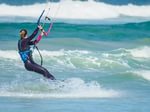
Dahab, Egypt – May 29, 2010: Rugged desert mountains meet the sea at this resort town in the Sinai Peninsula on the Gulf of Aqaba. Swimmers and sunbathers are beside the sea, and the buildings are part of a guesthouse and restaurant.
Getty
Hailed the “Middle East’s prime beach resort of independent travelers” by Lonely Planet, Dahab was once the center of a 1960’s Israeli occupation. For decades, everyone from backpackers to thrill-seeking tourists have turned to Dahab for adventure.
But a few years ago, the area was the subject of international attention for all the wrong reasons.
After a few incidents at the Sharm el-Sheikh International Airport that led to flight bans from countries including the United Kingdom, the area saw a drop in tourism.
But a lack of tourists isn’t necessarily a bad thing.
It’s helped bring the local marine life and reefs back to a good place; food and accommodation prices are some of the most reasonable; and with near-perfect year-round water temperatures, favorable wind conditions, and mild winters, Dahab is, and has always been, a secret paradise.
A comeback tour, then, was inevitable. Here’s what adventure travelers have known all along about Dahab, and what you should know too.
You can experience the world’s best diving for only 22 euros a tank.
From vibrant corals and an abundance of sea life to the world’s deadliest dive site, the Red Sea’s best dive sites have thrived as a result of slow tourism. And with dive centers like Red Sea Relax Dahab only charging between 22 and 35 euros a tank, there’s never been a better reason to get in the water.
Get introduced to one of the most diverse and abundant mixes of sea life in the Canyon, a shore dive with a gradual, but beautiful descent. Upon reaching the canyon and its champagne bubble effect (a result of other divers descending below) prepare to be mesmerized by not only the water’s clarity and temperature, but by the octopi, potato groupers, coral groupers, hawksbill sea turtles and tuna that are all a regular spectacle here. But keep in mind: advanced certification is required for this dive as you’ll reach a depth of 30 meters.

Dahab canyon is one of the most beautiful place to dive at Red Sea.Especily when no horde of divers in it.
Getty
El Bells is another local and visitor favorite since it’s essentially the gateway to the Blue Hole, which is often referred to as the world’s deadliest dive site. Without a bottom to gauge your depth and knowing some of the tales of divers who have gone missing here, it’s one of the eeriest dives you might ever experience (and one you certainly want to cross off your diver’s bucket list!).
Lighthouse, a shore dive you can do right from downtown Dahab (and steps from the Red Sea Relax Dahab dive shop), doesn’t have all of the spectacles of the other two sites (with the exception of one giant – and very curious – Napoleon wrasse who’s a regular resident here), but with underwater sculptures of Poseidon and a larger-than-life-elephant, it’s an easy dive perfect for ending a long day with.
Freedivers of all levels flock here.
With plenty of outfitters for freedivers, from Freedive Dahab to Blue Ocean Freedivers, Dahab is considered the freediver training mecca for the budget-conscious traveler.
And it’s not just novices and the freediving-curious who are flocking to Dahab; national and world-champion freedivers have been known to spend months training here thanks to the warm winter weather and affordable prices.
Especially since the Blue Hole offers a pretty perfect place to concentrate on skills without battling the elements. There’s no current, visibility is fairly consistent (but is season dependent), you don’t have to battle with boats (just other tourists), and year-round warm water temperatures make this a popular, but still under the radar (for now), spot for the freediving community.

Freedivers in training.
Getty
Hike Mount Sinai, one of the holiest mountains in the world, at sunrise is one of the most breathtaking experiences you can have anywhere in the world.
It’s said that Mount Sinai is the site where Moses received the 10 Commandments, making it one of the most religious mountains in the world. It’s also one of the most beautiful.

Hiking the Steps of Penitence route on Mount Sinai, Egypt.
Getty
But, in order to reach the peak just before sunrise, that means leaving your Dahab hotel at 11 pm at night. That will put you on the trail by 2 am, but not until after you’ve passed through some five, heavily guarded checkpoints on the roads along the way. Which means – don’t be alarmed by the armed guards and military trucks sitting along the route, whom you’ll likely have to show your passport to at least once before entering the mountain’s final checkpoint, their presence is for the good of the area.
It’s a sunshine oasis for kiteboarders and windsurfers.
The Dahab Lagoon, nicknamed ‘the blue lagoon,’ is the perfect place to learn to kiteboard or windsurf. Not only does the region boast of year-round warm water temperatures and an average of 280 days of wind over 4 Beaufort (the scale used for measuring wind speeds), but there’s an abundance of kiteboarding and windsurfing shops a stone’s throw from resorts – like the 4-star Swiss Inn, where I happened to stay when I visited – to choose from.

Kite in a jump. Red sea. Dahab. Egypt.
Getty
Pick from the Dahab Stars Windsurfing and Kiting Club, located just across the street from the Swiss Inn, or the Vetratoria windsurfing store, Harry Nass Dahab Worldclass Windsurf & Kitesurf Centers, or Soul Kiters Kitesurfing School – they’ll all get you geared up and ready to take on the lagoon.
Rock climb your way through the wadis with the guidance of the local Bedouin people.
The ideal time to rock climb in Dahab runs from October to April, when temperatures are favorable and conditions are dry. During these months, climbers find plenty of dry granite rock for sport climbing (permanent anchors and ropes are fixed to the rock for protection and from where a climber is clipped in to protect them during a fall), bouldering (climbing small rock formations, or boulders, without the use of ropes or harnesses), as well as trad climbing (climbers are harnessed in and place all gear required to protect against a fall into the rock as they climb it, removing it when a pitch is complete).

old kettle by the fire and people sitting next
Getty
Wadi Kid and Wadi Nassup are two up-and-coming climb sites, while Wadi Qnai is one of the more popular spots. Wadi Ki and Wadi Nassup both offer more multi-pitch than Wadi Qnai, which makes them great spots for beginners.
Part of what makes climbing so special here is the Bedouin people. It’s required for climbers to have a guide when they head into the desert, which also subsequently exposes you to the culture. The guys at Desert Divers are particularly well-versed in the area’s best climbing.
Explore the canyons by foot, ATV, or better yet, by camel.

Limestone mountains in the desert. Sinai, Egypt
Getty
From Colored Canyon, Egypt’s Antelope Canyon equivalent, to Mushroom Rock, it’s not a stretch to say that Dahab’s land rivals what’s underwater.
Be sure to explore the White Canyon, where eroding sandstone and blankets of white sand lead to the narrow entrance of Ain Khudra, an unreal, too-good-to-believe oasis featuring date palms and water springs.
With narrow, winding paths, the best (and really, only) way to explore these canyons is either by foot or ATV. Of course, you can do most of these tours by camel or horseback as well, like the locals have been doing for ages.





Recent Comments